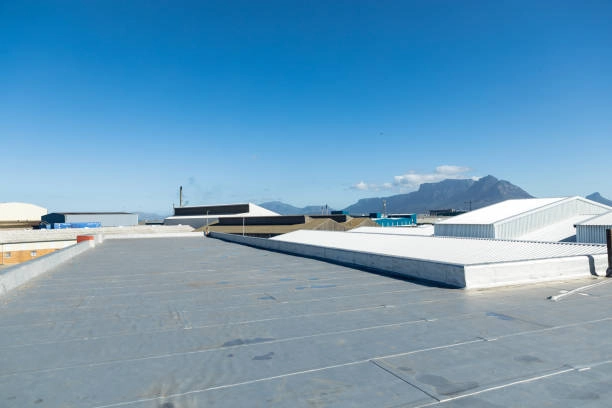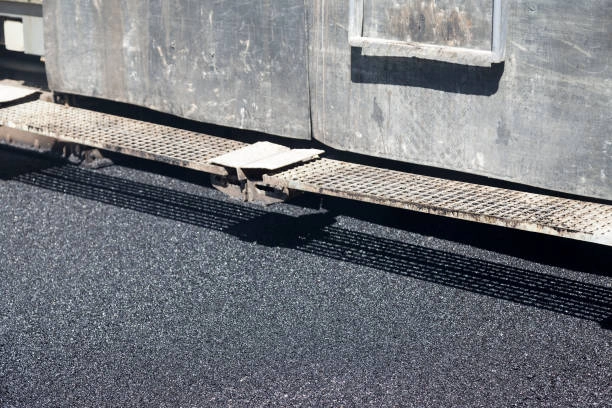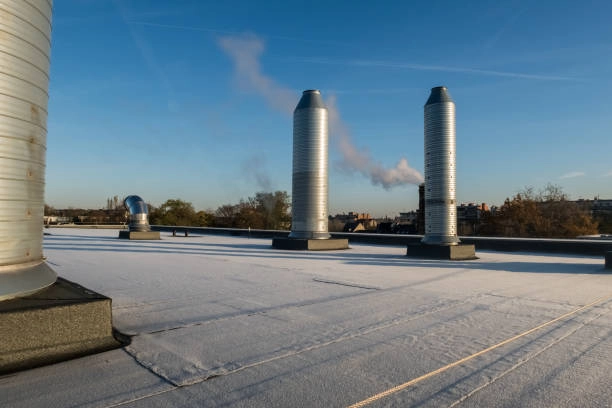Flat roofs are a practical and versatile choice for both residential and commercial buildings. They offer a modern aesthetic, efficient use of space, and cost-effective installation. However, not all flat roofs are created equal—there are various types, each with unique features, benefits, and challenges. This article will guide you through the different flat roof types, helping you make an informed decision for your next roofing project.

What Is a Flat Roof?
A flat roof is nearly level compared to sloped roofs, with a slight pitch (usually less than 10°) to allow water drainage. Flat roofs are common in arid climates and commercial buildings due to their cost efficiency and ability to maximize usable space. There are various flat roof types, each designed to suit different needs and environments. While they require proper drainage systems and durable materials to prevent water pooling, they remain a popular choice for their versatility.
Types of Flat Roofs
Flat roofs come in several types, each designed to meet specific needs. Below are the most common flat roofing systems:
1. Built-Up Roofing (BUR)
Built-up roofing, often referred to as “tar and gravel” roofing, is one of the oldest flat roof types. It consists of multiple layers of roofing felt alternated with waterproof materials like asphalt or coal tar. The final layer is topped with gravel or crushed rock for added protection.
Advantages:
- Multiple layers provide excellent waterproofing and durability.
- Offers fire resistance due to the gravel top layer.
- Long lifespan (15–30 years) with proper maintenance.
Disadvantages:
- Installation can release toxic fumes when using hot asphalt methods.
- Heavy weight may require additional structural support.
- Susceptible to cracking in cold climates due to freeze-thaw cycles.
2. Modified Bitumen Roofing
Modified bitumen is an evolution of flat roof types like BUR systems, using asphalt-based sheets reinforced with fiberglass or polyester. These sheets are applied in layers using heat or adhesives.
Advantages:
- Lightweight compared to BUR systems.
- Resistant to UV damage and weathering.
- Easy installation and repair process.
Disadvantages:
- It has a shorter lifespan than single-ply systems (10–20 years).
- Requires regular maintenance to prevent wear.
3. Single-Ply Membrane Roofing
Single-ply membranes are among the most popular flat roofing materials today due to their reliability and versatility. They come in two main types:
Thermoset Membranes (EPDM)
Made from rubber polymers, EPDM membranes are durable and flexible, ideal for extreme temperatures.
Thermoplastic Membranes (TPO/PVC)
These are made from plastic polymers and reinforced with fiberglass or polyester for added strength.
Advantages:
- Lightweight and easy to install.
- Highly resistant to UV rays and chemicals.
- Long lifespan (20–30 years).
Disadvantages:
- Higher upfront cost compared to BUR systems.
- Requires skilled installation for proper sealing.
4. Sprayed Polyurethane Foam (SPF)
SPF is a liquid-applied roofing system that forms a seamless layer when sprayed onto the roof surface. It’s ideal for irregularly shaped roofs or those requiring additional insulation.
Advantages:
- High insulation value reduces energy costs.
- Seamless application prevents leaks effectively.
- It can be applied directly over existing roofing materials during flat roof replacement projects.
Disadvantages:
- Limited track record compared to other systems.
- Requires professional application for consistent results.
5. Concrete Flat Roofs
Concrete flat roofs are common in areas with minimal rainfall due to their durability and ability to withstand heat exposure.
Advantages:
- Extremely durable and low-maintenance in dry climates.
- Provides excellent thermal insulation properties.
Disadvantages:
- Heavy weight requires strong structural support.
- Not suitable for areas prone to freezing temperatures as water can seep into cracks.

Choosing the Right Flat Roofing Material
Selecting the best flat roofing material depends on several factors:
1. Climate
Consider your local weather conditions when choosing a flat roof type:
- For hot climates like Phoenix, AZ, materials like TPO or concrete work well due to their heat resistance.
- In areas prone to heavy rainfall, single-ply membranes with proper drainage systems are ideal.
2. Budget
While BUR systems may be more economical upfront, single-ply membranes offer better long-term value due to their durability and lower maintenance requirements.
3. Building Use
Commercial buildings may benefit from energy-efficient options like SPF or TPO membranes, while residential properties might prefer BUR or modified bitumen for affordability.
4. Lifespan
If longevity is your priority, opt for single-ply membranes or BUR systems that can last 20–30 years with proper care.
Common Challenges with Flat Roofs
While flat roofs offer many advantages, they also come with unique challenges:
1. Drainage Issues
Flat roofs require efficient drainage systems like scuppers or internal drains to prevent water pooling and leaks.
2. Maintenance Needs
Regular inspections are essential for identifying wear and tear early on.
3. Vulnerability to Cold Weather
Flat roofs can struggle in colder climates due to ice dams or freeze-thaw cycles affecting materials.
Why Choose Gleason Roofing for Your Flat Roof Installation?
At Gleason Roofing, we specialize in providing high-quality flat roof solutions tailored to Phoenix’s unique climate challenges. With over 50 years of collective experience, our team ensures that every project is completed with precision and care.
What Sets Us Apart?
- Expertise: Our licensed professionals have extensive experience working with all types of flat roofing material.
- Quality Materials: We use only top-grade products designed for durability and energy efficiency.
- Customer Satisfaction: With an A+ rating from the Better Business Bureau, we’re committed to exceeding expectations in service and workmanship.
- Local Knowledge: Based in Phoenix, AZ, we understand how the desert climate impacts flat roofing performance—and we design solutions accordingly.

Flat roofs are an excellent choice for modern buildings due to their versatility, cost-efficiency, and energy-saving potential—but choosing the right flat roof types is crucial for long-term success. Whether you opt for BUR systems, single-ply membranes like EPDM or TPO, or innovative solutions like SPF roofing, understanding your options will help you make the best decision.
For reliable flat roof installation services backed by decades of experience, trust Gleason Roofing in Phoenix, AZ! Contact us today for expert advice on selecting the perfect flat roof type for your property!
Frequently Asked Questions
1. What are the most popular types of flat roofs for commercial buildings?
The most common flat roof types for commercial buildings are Built-Up Roofing (BUR), Modified Bitumen, Single-Ply Membranes (EPDM, TPO, PVC), Sprayed Polyurethane Foam (SPF), and Concrete Flat Roofs. Each type has its own benefits. These include durability, cost-effectiveness, and good energy use, based on the building’s needs and climate.
2. Which flat roofing type is best for hot climates?
In hot places, flat roofs like TPO and concrete work well because they handle heat. TPO sends back sunlight, which helps keep rooms cool. Concrete acts as a buffer to control temperature. Picking the right flat roof material helps save energy and makes it last longer in the heat.
3. Are flat roof tiles good for flat roofs in homes?
Flat roof tiles are usually not the best choice for homes with flat roofs because they are heavy and can cause drainage problems. Instead, materials like EPDM, Modified Bitumen, or TPO are better. They are lighter, last longer, and are easier to take care of. This makes them more suitable for homes.
4. How do I choose the best flat roofing material?
Choosing the right flat roofing depends on things like weather, how the building will be used, budget, and how long you want it to last. Think about EPDM for flexibility, TPO for energy, and BUR for strength. Talking to a professional can help you figure out which roof type is best for your needs.
5. What care do different flat roof types need?
Maintenance varies by roof type:
- BUR: Regularly check gravel and patch asphalt.
- Modified Bitumen: Look at seams and put on coatings as needed.
- Single-Ply Membranes: Check for holes and the condition of the membrane.
- SPF: Reseal often to keep it waterproof.
Regular care helps each flat roofing material last longer.
6. Can flat roofs handle heavy rain well?
Yes, some flat roof types like Single-Ply Membranes (TPO, PVC) are made for good water flow. When you install flat roof drains and keep gutters clean, it lessens the chance of water gathering. Picking a waterproof flat roof and having a small slope helps guard against water problems in rainy areas.
7. SPF is seen as a groundbreaking option for flat roofs.
SPF is a liquid that goes on flat roof types and hardens to create a strong, insulated layer. It fits well on uneven surfaces and gives good waterproofing. This type of flat roof is liked for its insulation and for helping to lower energy bills. That makes it a popular choice for businesses.
